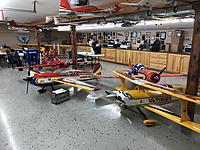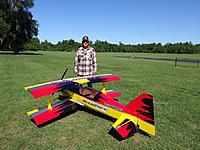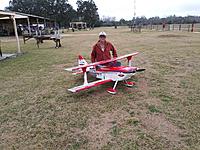|
|
||
|
|
Pitts/Wolf Samson
Quote:
Steve flew the Samson for 9 years after it's 1985 completion and stated it was his favorite airshow performer of all. It was Steve's with the colors of Ben Huntley's that inspired me many years ago. I will proceed with that one in 1/3. Thank you. A fellow in Australia built an excellent large RC example of Wolf's version many years ago. Photo is Wolf's 1985 Samson after Bobby acquired it. Thanks again Whiplash48 |
|
|
|
|
|
|
|
|
Curtis Pitts wing patent.
Described is Curtis Pitts Patent on the S1S Wings that give the aircraft the the same flight characteristics inverted as in upright flight.
https://patents.google.com/patent/US3695557 Pitts Airfoils Pitts Model 12 NACA 63a015 (upper) NACA 0012 (lower) Pitts Model 14 NACA 23012 NACA 23012 Pitts S-1C NACA M-6 NACA M-6 Pitts S-1D NACA M-6 NACA M-6 Pitts S-1E Symmetrical Symmetrical Pitts S-1S NACA 63a015 (upper) NACA 0012 (lower) Pitts S-1T Symmetrical Symmetrical Pitts S-1-11 NACA 63a015 (upper) NACA 0012 (lower) Pitts S-2A NACA 63a015 (upper) NACA 0012 (lower) Pitts S-2B NACA 63a015 (upper) NACA 0012 (lower) Pitts S-2C NACA 63a015 (upper) NACA 0012 (lower) Pitts S-2E Symmetrical Symmetrical Pitts S-2S NACA 63a015 (upper) NACA 0012 (lower) Pitts Samson NACA- 23012 (upper) NACA- 23012 (lower) Pitts S-1E, S-1T and S-2E... are also the same NACA 63a015 upper, NACA 0012 Lower |
|
|
|
|
|
Can't wait to see the finished airplane sometime. When we were looking for a biplane subject to do for the '84 TOC, I had no idea there was a Pitts Samson. A good friend and fellow pilot suggested the Stearman as an obvious choice. The two have a lot in common.
Attached is my attempt at a set of plans for the Samson in your picture; I started these back in 2014 as a possible IMAC/TOC biplane build. I have a DA-170, I may just have to start cutting some plywood for this project... |
|
|
|
|
|
Big Bipes
I can't wait to have a half built airplane. It has been a long time coming. I'll post a progress photo. The Stearman is a personal favorite. I built the 64" Sterling Kit when it was current. It was a Giant Scale then. And I was just a kid.
|
|
|
|
|
|
Pitts S2-C 3 views
These came from a binder at Christen Industries. They are not available on the net. I assume they are accurate. In comparison to 3-view of a Pitt's S2C owned by Brett Hunter, a single seater, it appears all are correct. A series of 3 views from Aviat of the S2A, S2B and S2S many years ago looked nice but were not accurate for the purposes of scaling a model from. Likely to protect their proprietary products. Model Building has taken a karmic hit in last 2 decades. I hope these are of value to someone. A Ryobi S2C ARF had the only 3 view available around 2003. I charmed these out of the girl that answered the phone at Christen in 2006.
Brett Hunter's is attached for reference. |
|
|
|
|
|
I do not know to be honest.
[QUOTE/ MB - -can you help with this Question?
Flight Wise what would the difference between an Ultimate and a Challenger II?, Which would be more docile, Land slower etc?[/QUOTE] Hi HODGE, I can't honestly answer that one. I have not flown the Challenger but I am going to guess it would land slower than the Ultimate all else being equal. |
|
|
||
|
United States, VA, Virginia Beach
Joined Jun 2006
113 Posts
|
Quote:
I have my Ulti from 2005 and I fly it every year and I haven't yet been able to overshoot a landing, but always needing to drag it in under power, but then again I don't have an ordinary Ulti, meanwhile my Christen eagle or Pitts is generally cruised by the pilot boxes on landings |
|
|
|
|
|
|
Sport Aviation Article October 2015
A great article for Pitts enthusiasts. It was to large to Post. Whiplash48 remedied that. Thank you. All issues were sold out immediately. This prints off nicely for those who collect.
|
|
|
|||
|
|
Quote:
Quote:
I have my Ulti from 2005 and I fly it every year and I haven't yet been able to overshoot a landing, but always needing to drag it in under power, but then again I don't have an ordinary Ulti, meanwhile my Christen eagle or Pitts is generally cruised by the pilot boxes on landings[/QUOTE] Thanks you both for the Information  Ill stick to the challenger then Ill stick to the challenger then 
|
||
|
|
|
|
|
2019 Reboot!
Sr. TOC Reboot.
|
|
|
|
|
|
Can one of you explain the differences/reasoning behind horizontal stab location on these? I note the Pitts S2 in the above post has the H stab basically on the thrust line, while the Pitts Samson has it higher, as do most current full scale monoplanes we all see in RC--Extra, Edge, MXS, etc.
The 3D-optimized arfs we all have access to now have morphed into nearly the same plane, with thrust line, wing, and H stab basically in the same plane, unlike most of their fullscale counterparts... |
|
|
|
|
|
Hodge, I have three Pitts, an S1T at 96", a Challenger at 86", and a S1C at 61". I also have two Ultimates, one at 94" and one at 82". The Ultimate has much more authority in flight as it was designed for better aerobatics. As for landing, it all depends on the weight as to the speed needed on approach. The S1C, Challenger, and both Ultimates were designed and built light. I think they are comparable in landing but I would give a nod to the Ultimates. By the Ultimate's design they just seem to float a little more. As for the first one the S1T, it turned out to be a tank weight wise but was built for show more than aerobatics. My favorite for flying is by far the Aeroworks Ultimate, did it light and it flies like a dream and will float in for a feather soft touch down.
|
|
|
||
|
|
Quote:
The vertical HS offset is measured from the 33% root chord line. Which is where I have generalized the pitch moments act. The actual 0 moment point is most dependant on the airfoil used. Some of my own experiments with the NACA 0010 and 0012 sections shows the 33% location to be very close with an elevator to HS area ratio of about 40 / 60 with the 40% being the elevator area. We see for the Falcon the HS is ~1,5 in. below the thrust line, Stearman was only ~0.6 in. and the estimated Prettner Super Skybolt is the lowest at ~ 2.1in. I know from discussions at the time that the Stearman had much worse Yaw/Roll coupling issues than the Falcon did. Steve Rojecki, ('84 Winner) did a beautiful combination horizontal flat turn into a knife edge loop during his 3 minute free program. Simple, but amazing none the less. |
|
|
|
||
|
|
Quote:
|
|
|
|
||
|
|
Right on
Quote:
I'm relieved to see you post this vital information. It is all true. Hal Debolt and his contemporaries (the pioneers) went for no coupling, or as little as possible in their search for aerodynamic predictability and stability. There is no argument I can see in refuting your assertions. Some model owners may find themselves in position to do little about the set up they have. Anyone designing will take it under advisement. Anyone who has read and understood the premise will be rolling it over in thought. This insight deserves a reply and due credence. Thanks for bringing it up, or should I say putting it in perspective. -Bill |
|
«
Previous Thread
|
Next Thread
»
| Currently Active Users Viewing This Thread: 2 (0 members and 2 guests) | |
| Thread Tools | |















